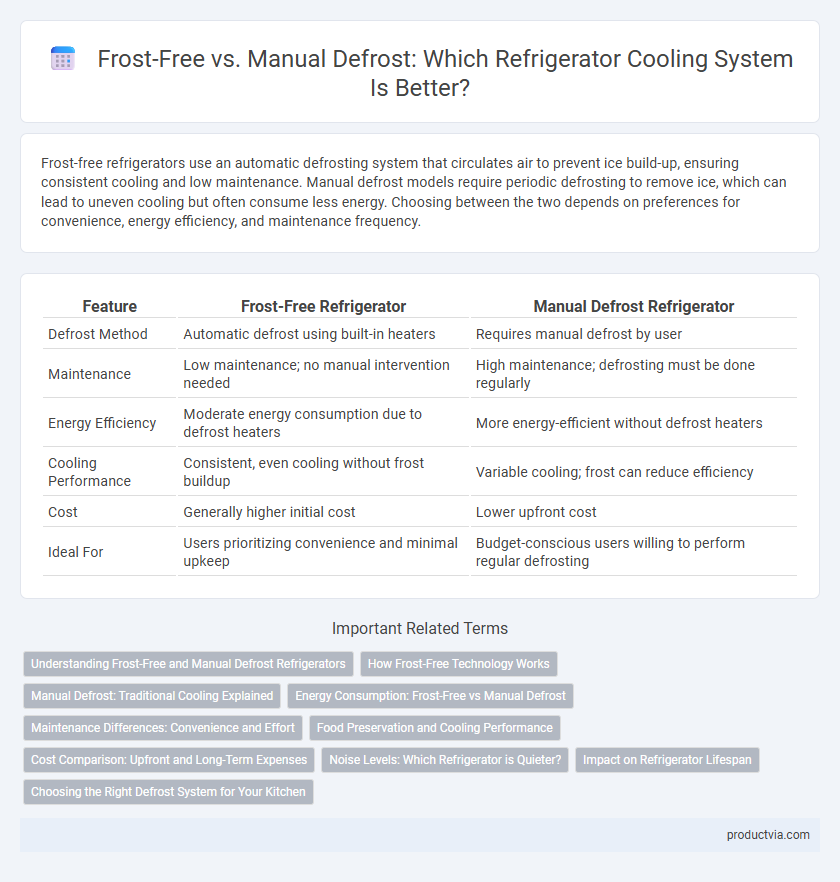Frost-free refrigerators use an automatic defrosting system that circulates air to prevent ice build-up, ensuring consistent cooling and low maintenance. Manual defrost models require periodic defrosting to remove ice, which can lead to uneven cooling but often consume less energy. Choosing between the two depends on preferences for convenience, energy efficiency, and maintenance frequency.
Table of Comparison
| Feature | Frost-Free Refrigerator | Manual Defrost Refrigerator |
|---|---|---|
| Defrost Method | Automatic defrost using built-in heaters | Requires manual defrost by user |
| Maintenance | Low maintenance; no manual intervention needed | High maintenance; defrosting must be done regularly |
| Energy Efficiency | Moderate energy consumption due to defrost heaters | More energy-efficient without defrost heaters |
| Cooling Performance | Consistent, even cooling without frost buildup | Variable cooling; frost can reduce efficiency |
| Cost | Generally higher initial cost | Lower upfront cost |
| Ideal For | Users prioritizing convenience and minimal upkeep | Budget-conscious users willing to perform regular defrosting |
Understanding Frost-Free and Manual Defrost Refrigerators
Frost-free refrigerators use an automatic defrost system that prevents ice buildup by periodically heating the cooling coils, ensuring consistent temperature and eliminating the need for manual thawing. Manual defrost refrigerators require the user to turn off the unit and remove ice buildup periodically, which can improve energy efficiency but demands regular maintenance. Understanding these cooling methods helps consumers choose between convenience and energy savings based on their lifestyle and usage patterns.
How Frost-Free Technology Works
Frost-free refrigerators use built-in fans and heating elements to circulate cold air evenly while periodically warming the evaporator coils, preventing frost buildup. This technology eliminates the need for manual defrosting by automatically melting any accumulated ice and draining the water outside the cooling compartment. The continuous airflow ensures consistent temperature control, enhancing energy efficiency and food preservation compared to manual defrost models.
Manual Defrost: Traditional Cooling Explained
Manual defrost refrigerators utilize a traditional cooling system where ice buildup occurs on the evaporator coils and requires periodic melting to maintain efficiency. This method involves turning off the appliance and allowing the frost to thaw naturally, preventing excessive ice accumulation that can hinder cooling performance. Manual defrost models are often more energy-efficient initially but demand regular maintenance compared to frost-free technology.
Energy Consumption: Frost-Free vs Manual Defrost
Frost-free refrigerators use an automatic defrosting system that cycles on periodically, increasing overall energy consumption by about 10-15% compared to manual defrost models. Manual defrost refrigerators maintain lower energy use by avoiding the continuous operation of fans and heating elements, but require regular manual intervention to remove ice buildup. Choosing a manual defrost refrigerator can result in significant energy savings, especially in regions with stable ambient temperatures.
Maintenance Differences: Convenience and Effort
Frost-free refrigerators feature an automatic defrost system that prevents ice buildup, significantly reducing maintenance efforts and ensuring consistent cooling performance without manual intervention. Manual defrost models require regular defrosting to remove ice accumulation, demanding more time and physical effort to maintain optimal cooling efficiency. Choosing frost-free technology enhances convenience by eliminating the need for scheduled defrosting, making it ideal for users prioritizing low-maintenance appliances.
Food Preservation and Cooling Performance
Frost-free refrigerators use automatic defrost cycles to prevent ice buildup, ensuring consistent cooling temperatures that better preserve food freshness and texture. Manual defrost models require regular manual melting of ice, which can lead to temperature fluctuations and potential spoilage if not managed carefully. The consistent cooling performance in frost-free units enhances food preservation by maintaining optimal humidity and preventing freezer burn.
Cost Comparison: Upfront and Long-Term Expenses
Frost-free refrigerators generally have higher upfront costs due to advanced defrosting technology, but they reduce long-term expenses by preventing ice buildup and maintaining consistent cooling efficiency. Manual defrost models are initially cheaper but require regular defrosting, leading to increased energy consumption and potential maintenance costs over time. Consumers should consider these factors to balance initial investment against operational savings when choosing between frost-free and manual defrost refrigerators.
Noise Levels: Which Refrigerator is Quieter?
Frost-free refrigerators operate with a built-in fan and automatic defrost cycle that may produce occasional humming or clicking sounds, while manual defrost models lack this mechanism, resulting in generally quieter operation. Manual defrost refrigerators avoid the noise generated by defrost heaters and fans, making them preferable for noise-sensitive environments. However, the overall noise difference varies by brand and model, with frost-free units often featuring advanced insulation and sound-dampening technology to minimize disturbances.
Impact on Refrigerator Lifespan
Frost-free refrigerators use an automatic defrost system that prevents ice buildup, significantly reducing the risk of compressor strain and extending the appliance's lifespan by maintaining optimal cooling efficiency. Manual defrost models require regular removal of frost buildup, which if neglected, can lead to increased energy consumption and potential damage to refrigerator components. Studies indicate that frost-free units typically offer longer operational life due to consistent temperature regulation and less mechanical stress on cooling parts.
Choosing the Right Defrost System for Your Kitchen
Frost-free refrigerators use automatic defrost cycles to prevent ice buildup, ensuring consistent cooling performance and low maintenance. Manual defrost models require periodic defrosting by the user but often consume less energy and can be more affordable. Choosing the right defrost system depends on your kitchen habits, energy efficiency preferences, and willingness to perform maintenance.
Frost-Free vs Manual Defrost for Refrigerator Cooling Infographic

 productvia.com
productvia.com